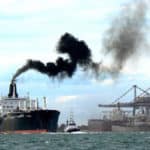Actionable data is key to reducing shipping’s carbon footprint

Maritime’s voyage to decarbonisation is underway, with shipping companies exploring technologies that harness wind, waves and even air bubbles to ensure their ships burn less fuel. Improved vessel design is making ships more efficient and safer for seafarers, and alternative fuels are being explored to help reduce the industry’s impact on climate change. However, there is another option to add to those already in play: navigational data.
Modern mariners now rely on a sophisticated network of sensors, satellite systems and the latest technologies to gather data about their vessel’s journey. Using GPS and radar systems, weather forecasts and real-time voyage data, they can establish a clear picture of the maritime environment. Such information also gives them visibility of the surrounding sea conditions, depths, currents and tides.
Navigational data supports decarbonisation, enabling seafarers and fleet managers to reduce a vessel’s emissions by optimising its speed, route and operations. Previous generations of mariners with no access to this information would often follow established routes that may be less fuel-efficient, generating more emissions than necessary. But the arrival of data analytics and machine-learning algorithms allow shipping companies to identify the shortest, most optimal routes based on favourable currents, winds, and sea conditions, by comparing historical navigational patterns to real-time data.
When integrated with sophisticated carbon monitoring systems on board, navigational data enables shipping companies to track a vessel’s fuel consumption and emissions in real-time. As such, they can make necessary adjustments to optimise the ship’s performance.
The benefits of data are there to be unlocked both at sea and on shore. Accessing near real-time information is a gamechanger for optimising port arrivals. With data sharing between ports and ships, fleet managers and crewmembers can speed up, slow down or update their course to ensure they arrive right on time. A just-in-time arrival enables them to approach a port exactly when they are due, cutting out the need to wait in line for a berth or idling in anchorages, which in turn minimises downtime and emissions.
Such precision could have a positive impact on the environment, with the International Maritime Organization estimating that just-in-time arrivals may, in the near term, reduce fuel consumption and emissions by 11%.

Charlie Fardon
The UK Hydrographic Office is contributing to the advancement of just-in-time arrivals through our participation in the Blue Visby Consortium, which aims to bring to market the Blue Visby Solution (BVS). The BVS introduces a queuing system for ships bound to the same destination port. The system will synchronise and optimise the ocean passages of a group of vessels, allocating optimised arrival times, and ensuring an arrival frequency at which the port can handle.
As well as unlocking just-in-time arrivals, navigational data is also key to helping establish green shipping corridors. These corridors, which are marked by optimised routes and sustainable practices, offer a blueprint for reducing the carbon footprint of maritime transportation. They involve public and private stakeholders carrying out actions and initiatives, related to port and ship technology, fuel usage, and voyage optimisation. Green corridors can operate domestically, short-sea or across continents and multiple ports.
Navigational data plays such a pivotal role because of its ability to clearly and accurately represent the marine environment that ships must travel through. This information is invaluable for planning, monitoring and optimising activity within a green shipping corridor – and may even be able to be used to underpin investments in fuel and other marine infrastructure.
The shipping industry’s ongoing journey towards a greener future relies on navigational data that will reshape how vessels navigate the world’s oceans. By harnessing the full power of such information, the sector can achieve its decarbonisation goals and support other industries working to tackle climate change.
Source: By Charlie Fardon, Head of Sustainability, UK Hydrographic Office
